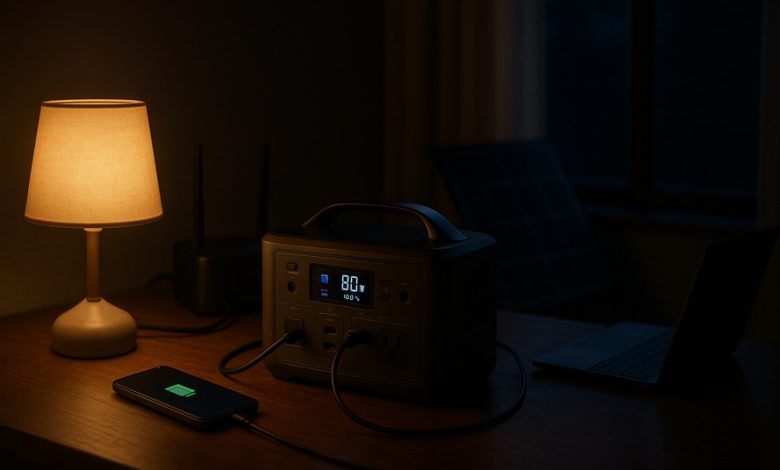
As the power flicked off on a quiet suburban block in the United States this year, the street went dark and silent; no more hum of current from lights, refrigerator or Wi-Fi router. Within minutes, a small solar generator on the kitchen counter had assumed control over critical loads. A router and modem were up and running again, phones fast charging, a small LED lamp brought light back to the room and everyone was calm. Later, the coffee maker and a laptop were run for brief stints, topping up the battery again by noon that day with the provided solar panels. That incident would serve as a model for countless households shopping for the best portable power station for storms, heat waves and public safety shutoffs.
A Now-You-Do-It Exercise in Imitation
In the United States, the leading pattern of power outages is weather. Winter ice breaks lines in the Midwest, wind events shut down power in parts of California and summer storms dark windows for hours on the East Coast. In both instances the basic needs are the same. Keep in touch with communications, secure food, have some basic lighting and recharge small devices. A midsize solar generator with a pure sine wave inverter, and no less than 700 to 1,200 watt-hours generally meets the bar for covering these essentials for an attentive family in terms of what it is running and when. Throw two 100 to 200 watt solar panels into the mix, you get day recharge (which reduces needs on grid or gas).
What a Solar Generator Is (and What It Isn’t)
A solar generator is not an internal combustion engine. It is a portable electric power source incorporating an internal battery, an inverter for generating household AC electricity, regulated DC power outputs, and an MPPT solar charger control featuring solar input. You charge it from a wall outlet, from a car socket or from solar panels. The “generator” in the name refers to the way those panels can harvest sunlight and effectively serve as a source of silent, emission-free electricity for inside the dwelling.
Recent housings often incorporate LiFePO4 batteries, which offer excellent cycle life and constant performance. Units of NMC batteries may have a lower weight for the same capacity but a lower number of charge cycles compared to LiFePO4. Either chemistry can be made to work if the manufacturer manages the battery correctly, but for stationary home backup LiFePO4 has won out based on its longevity.
Why Some Households Choose a Portable Power Station Instead of a Gas Generator
Gas generators provide a lot of peak wattage, power appliances including most large air conditioning units and run on fuel (they also sit outside due to fumes and are noisy). A generator of the solar variety is quiet and safe to operate indoors with proper ventilation, plus it will power sensitive electronics because (with that inverter) the generated power is clean. No pull-start or oil change; just a power button. For pros pressing the equipment limits, they’re fine relegating digital sound to penance status in its own bin of justifiable trade-offs. For apartments, condos and urban neighborhoods where noise and storage are actual problems, something battery-based is usually the only real backup solution.
Another key difference is maintenance. A gas generator wants to be run regularly, and with seasonable attention to the carburetor, kept relatively pristine. A portable one benefits from a top-up every couple months, and an occasional cycle to make sure the cells are balanced. Many techniques include an uninterruptible power feature that will switch to backup battery power within milliseconds, saving routers, desktops and NAS drives from hard shutdowns.
How to Size the Best Portable Power Station for Outages
Start with a simple tally. The things you need in your house, write them out and then note their watts, and how many hours per day you have to run each one. Multiply watts by hours to get watt-hours.
- Router and modem example: if they draw 20 watts for 24 hours, that is 480 watt-hours.
- Mini fridge example: 60 to 100 watts depending on size and model, with about 80% increase in energy consumption when you first turn it on. If it runs 8 hours of real compressor time in a day at 80 watts, that is 640 watt-hours.
- Add LED lighting (10 to 20 watts) for a few hours and a couple of phone and laptop charges.
Used conservatively, you are left with something closer to 1,200 to 1,500 watt-hours per day.
Aim for an inverter that can support a constant draw of at least 1,000 watts with a higher surge rating, as appliances briefly spike when they turn on. If you will make coffee in the morning or power a microwave on occasion, look at a 1,500 to 2,000 watt inverter. Make sure the unit has high speed USB-C PD output at 60 to 100 watts, because that feature can charge laptops without turning on the AC inverter and draining energy.
Solar Input and Recharges That Make a Difference
- This tends to be quantified in watts and volts. With a portable battery pack that has an MPPT, good input might be between 200 and 400 watts of solar.
- Foldable panels are easy to move; even stiff panels installed on a balcony or patio may be more robust.
- AC charging of 500 to 1,000 watts thumping over ages, is great for a fast overnight top-up, while having a fan profile that is not too noisy to run indoors.
- Auto charging is a slower, safe rate and may operate not when driving.
- If you want seamless power for a pc or home network, find a model with a UPS or a transfer. Since it remains connected, these serve to pass grid power to the computer. If things do not work, they switchover to the battery fast enough to keep you from having to boot.
- Port selection should be a concern. Two or two AC shops reduce the demand for PCs. To keep newer gadgets satisfied, include at least one 100W USB-C PD port as well as various USB-A sources. A 12v managed store powers a cooler or a portable radio. At night, a nice night light preserves electricity, and a display that reveals input and output in watts that you may coordinate your setups intelligently.
- Battery quality impacts battery life expectancy and the influence on the battery’s expenditure. LiFePO4 batteries up to a few thousand cycles. Other batteries provide growth kits that integrate under the main component, allowing you to start small and expand your capability later.
- Finally, manufacturing is crucial. Handles with a strong grip, a case, and a shoe would make it simpler to pass through your home. A cozy footprint is simple to store in the cabinet.
Safe Setup for Indoor Use
- Set the solar generator on a sturdy and ventilated surface, as close to your modem, router and refrigerator as possible.
- If you must use an extension cord, use the shortest one possible and one that is rated for the load.
- Prioritize essential loads. For a fridge or refrigerator, plug in for one or two hours and then unplug for an equivalent amount of time to save energy but maintain safe temperatures.
- Do not operate high-resistance appliances simultaneously.
- If you have panels, place them where they will get a few hours of direct sun, angle them toward the midday sky and connect them before the battery drops too low.
Cost, Value, and Total Ownership
The best portable power station is not the cheapest in every way on day one. Value is in cycle life, efficiency and recharge rate. Over several years, a LiFePO4 pack that can cycle daily thousands of times might cost less per delivered kilowatt-hour than a budget pack which fades rapidly. If you are using solar panels to partially charge things during the day, it screens some utility use. In an extended outage the savings come from not tossing spoiled food away, not needing to check into a hotel and being able to keep working from home.
Who Benefits Most
Homeworkers with a similar connectivity need, families with medical devices that must not lose power, students who are unable to risk losing study time, and renters who cannot put in permanent generators all gain. Motorhomes and camper vans realize the same benefits in movement. The portable model still makes sense for users who already own a full house backup unit, and want something more versatile that can be moved from the kitchen to the garage (or car).
A Rapid Purchasing Model for 2025
- Always make certain the capacity in watt-hours corresponds with your average plan.
- Choose an inverter with the rating even higher than the biggest single load.
- In particular, opt for pure sine wave output and LiFePO4 cells if you want it to last.
- Try to get at least one 100 watt USB-C PD port, two or more AC outlets, a non-ridiculously-dim readout and an MPPT controller that will actually accept an appropriate solar input range for the panels you are using.
- If auto is required, check for UPS (uninterruptible power supply) function and transfer speed.
- Examine the warranty duration, cycle ratings and availability of expansion batteries.
Bottom Line
A well-chosen solar generator/comfort stimulates a blackout from a scramble into a modest inconvenience. Enough capacity, a clean sine wave inverter, and fast recharge from wall or panels keep food cold, device running, and the lights on the best portable power station while your neighborhood waits for coherence. Define the essentials you need to power and match capacity and inverter size to those requirements, and the result is quiet, safe, and flexible support that serves you during the stormy and sunny weekends long after the grid comes back.
FAQs
How long will a solar generator power a fridge without electricity?
In most case, a mid-size portable power station in the 1,000- to 1,200-watt hour range can support an efficient modern refrigerator for eight to 12 hours of compressor operation time (usually enough for one full day if you minimize door openings). Results depend on ambient temperature, fridge size and duty cycle so build in some room into your capacity planning.
Can I plug in a space heater or air conditioner to a portable power station?
Technically it can be done if the inverter output watt rating is high, but these appliances are very energy hungry and will flatten your battery in no time. In an emergency to make things more comfortable, think about space heaters, electric throws, small fans or targeted cooling devices which use significantly less electricity.
Can you use a solar generator indoors?
Yes again, since it does not burn fuel or produce fumes. And always make sure vents are unblocked, the unit is not covered and you are using appropriately rated cords. The panels are left outdoors or near a window, and the station goes on a dry, stable surface.
How fast can I recharge with solar panels?
Under good sun, a 200W panel adds roughly 600-900 watt-hours over a sunny day, depending on latitude and weather. Two 200W panels mean many stations reach a full charge from half-empty in a few hours. Real performance depends on angle, temperature, shading, and the MPPT range of the power station.
What is the difference between LiFePO4 and other lithium chemistries?
LiFePO4 cells usually provide thousands of cycles and stable performance across many years with a modest weight penalty. NMC cells are lighter for the same capacity and are common in smaller or more travel-friendly stations. For home backup, LiFePO4 is frequently preferred because of longevity.



